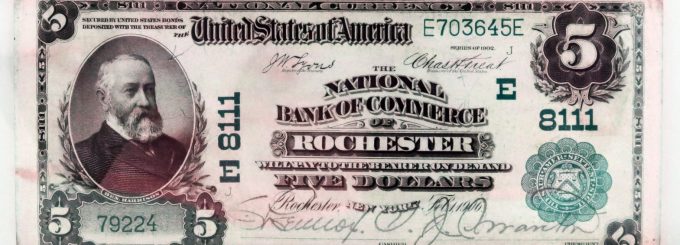Series of 1902 $5 NB of Commerce of Rochester NY Fr#599 VF25 PCGS

At its height, the National Rochester Bank issued almost $7 million in American currency, one of which is this bill. Whenever a bank issues such a large sum of money there usually isn’t much space for issues which are rare, but with Series of 1902 $5 NB of Commerce of Rochester there are exceptions.
History of This Note
In 1905 the bank first opened its doors and ceased issuing currency by 1920. This means that the bank printed bills for approximately sixteen years. In the banking industry, even back then, sixteen years wasn’t a long period of time. It issued nine currency denominations and its office was situated in the county of Monroe. The National Bank of Rochester was issued the 8026 charter number.
One of the things which make this bank unique is the number of sheets it produced. It issued a total of twenty thousand sheets for the $5 1902 note with the red seal, whereas most banks at the time didn’t print anything higher than ten thousand. Additionally, the majority of the national banks of the period preferred issuing $10 or $20 red seals rather than $5.
Note Features And Characteristics
The left side of the $5 bill displays an image of Ben Harrison. The charter date is also visible in cursive writing in years which range from 1902 to 1908. This charter date will not affect the value of the bill in any way. The bank also printed about 8400 $5 notes which display a blue seal rather than a red one. Notes which display a blue seal aren’t incredibly rare nor are they common, but somewhere in between. The blue seal notes were issued from 1908, and come in two versions. The first variant is referred to as the date back and has 1902-1928 appear on the back. The other version is referred to as the plain back since it does not display date stamps on the note’s back section. The value for such notes will vary depending on the bank that issued them and their condition.
Blue seal notes were also issued in denominations of $50, but there is no special knowledge in regards to determining which version holds the highest value. The value of every bill will ultimately come down to its condition, as well as the demand. A typical $50 note in good condition will go from $750 to $1250. The rarest Bank of Rochester bills can climb to $5,000 and above. As with many national banks at the time, NB Rochester issued $100 notes, which are very similar to the $50 bills in terms of sheet numbers. The reason for this is because the same sheets were used in their printing. The hundred dollars bills are quite rare, and a portrait of John J. Knox can be seen on the front. It is the back of the bill however that is most popular among collectors.


